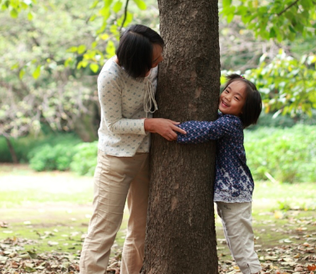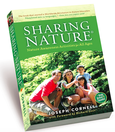Meet a Tree
Concepts, skills, and qualities taught: Forest appreciation, sensory awareness, empathy
When and where to play: Day / forest
Number of people needed: For 2 or more people
Suggested age range: Ages 4 and up
Materials needed: Blindfolds
When and where to play: Day / forest
Number of people needed: For 2 or more people
Suggested age range: Ages 4 and up
Materials needed: Blindfolds

Trees, said Buddha,have unlimited kindness and benevolence, and uplift the human spirit. Scientific studies show that trees calm us and provide spiritual and creative inspiration.
Meet a Tree connects us with trees in a memorable way. To play, divide the group into pairs and have one of each pair wear a blindfold. The seeing player—if old enough—leads the blindfolded player to a special tree, one that has intriguing characteristics. Upon meeting the tree, the blindfolded player feels the texture of the tree’s bark, sees how big the tree is by putting his arms around it, and explores the tree’s branches and leaves. The guide can silently guide the player’s hands to interesting places on and around the tree.
One Sharing Nature leader in Japan often tells children, “In this forest there is a tree that has been waiting to meet you since before you were born.” The children, touched by these words, are honored and eager to meet their tree.
After getting to know their trees, the blindfolded players are brought back to thestarting point, where their blindfolds are removed. They then try to find their tree. Most adults and children (except for the very young) who have walked blindfolded thirty yards or more to a tree, can find it later with open eyes. Leaders should, however, adapt the distance to the age, mobility, and the ability of the players to orient themselves in nature.
Faces of both children and adult players immediately glow with elation when they recognize their tree—it is as though two dear friends have reunited.
Children younger than twelve should probably be paired with an adult. Young children may also want to guide their adult friends: if so, the adult can look as needed for safety purposes.
Next activity
Meet a Tree connects us with trees in a memorable way. To play, divide the group into pairs and have one of each pair wear a blindfold. The seeing player—if old enough—leads the blindfolded player to a special tree, one that has intriguing characteristics. Upon meeting the tree, the blindfolded player feels the texture of the tree’s bark, sees how big the tree is by putting his arms around it, and explores the tree’s branches and leaves. The guide can silently guide the player’s hands to interesting places on and around the tree.
One Sharing Nature leader in Japan often tells children, “In this forest there is a tree that has been waiting to meet you since before you were born.” The children, touched by these words, are honored and eager to meet their tree.
After getting to know their trees, the blindfolded players are brought back to thestarting point, where their blindfolds are removed. They then try to find their tree. Most adults and children (except for the very young) who have walked blindfolded thirty yards or more to a tree, can find it later with open eyes. Leaders should, however, adapt the distance to the age, mobility, and the ability of the players to orient themselves in nature.
Faces of both children and adult players immediately glow with elation when they recognize their tree—it is as though two dear friends have reunited.
Children younger than twelve should probably be paired with an adult. Young children may also want to guide their adult friends: if so, the adult can look as needed for safety purposes.
Next activity
